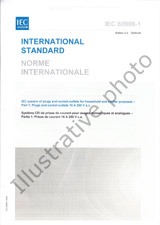We need your consent to use the individual data so that you can see information about your interests, among other things. Click "OK" to give your consent.

IEC 62680-1-8-ed.1.0
Universal serial bus interfaces for data and power - Part 1-8: Common components - USB Audio 3.0 device class definition terminal types
Translate name
STANDARD published on 19.9.2019
The information about the standard:
Designation standards: IEC 62680-1-8-ed.1.0
Publication date standards: 19.9.2019
SKU: NS-972770
The number of pages: 30
Approximate weight : 90 g (0.20 lbs)
Country: International technical standard
Category: Technical standards IEC
The category - similar standards:
Wires and symmetrical cablesR.F. connectorsInterface and interconnection equipment
Annotation of standard text IEC 62680-1-8-ed.1.0 :
IEC 62680-1-8:2019 is to describe in detail all the Terminal Types that are supported by the Audio Device Class. This document is considered an integral part of the Audio Device Class Specification, although subsequent revisions of this document are independent of the revision evolution of the main Audio Device Class Specification. This is to easily accommodate the addition of new Terminal Types without impeding the core Audio Device Class Specification. The Audio Device Class Definition applies to all devices or functions embedded in composite devices. All audio signals inside an audio function start at an Input Terminal, pass through some Units, and leave the function through an Output Terminal. Units can manipulate the signal in various ways. Terminals represent the connections of the function to the outside world. As part of the Terminal descriptor, the wTerminalType field specifies the vendor’s suggested use of the Terminal. For example, a pair of speakers is a more suitable target for music output than a telephone line. This feature allows a vendor to ensure that applications use the device in a consistent and meaningful way. LIEC 62680-1-8:2019 a pour objectif de decrire en detail tous les types de terminaux pris en charge par la classe des dispositifs audio. Le present document est vu comme faisant partie integrante de la Specification de classe de dispositifs audio, bien que les revisions ulterieures du present document soient independantes de levolution des revisions de la Specification de classe de dispositifs audio principale. Lobjectif est de faciliter la prise en compte de lajout de nouveaux types de terminaux sans affecter la Specification de classe de dispositifs audio de base. La definition de classes de dispositifs audio sapplique a tous les dispositifs ou fonctions integres dans des dispositifs composites. Tous les signaux audio au sein dune fonction audio partent dun terminal dentree, passent par des unites, puis quittent la fonction par un terminal de sortie. Les unites peuvent manipuler le signal de differentes facons. Les terminaux representent les connexions de la fonction au monde exterieur. Le champ wTerminalType, qui fait partie du descripteur de terminal, indique lutilisation suggeree par le fournisseur du terminal. Par exemple, une paire de haut-parleurs est une cible plus appropriee pour une sortie musicale quune ligne telephonique. Cette fonctionnalite permet a un fournisseur de sassurer que les applications utilisent le dispositif de maniere coherente et pertinente.
We recommend:
Technical standards updating
Do you want to make sure you use only the valid technical standards?
We can offer you a solution which will provide you a monthly overview concerning the updating of standards which you use.
Would you like to know more? Look at this page.



 Cookies
Cookies
